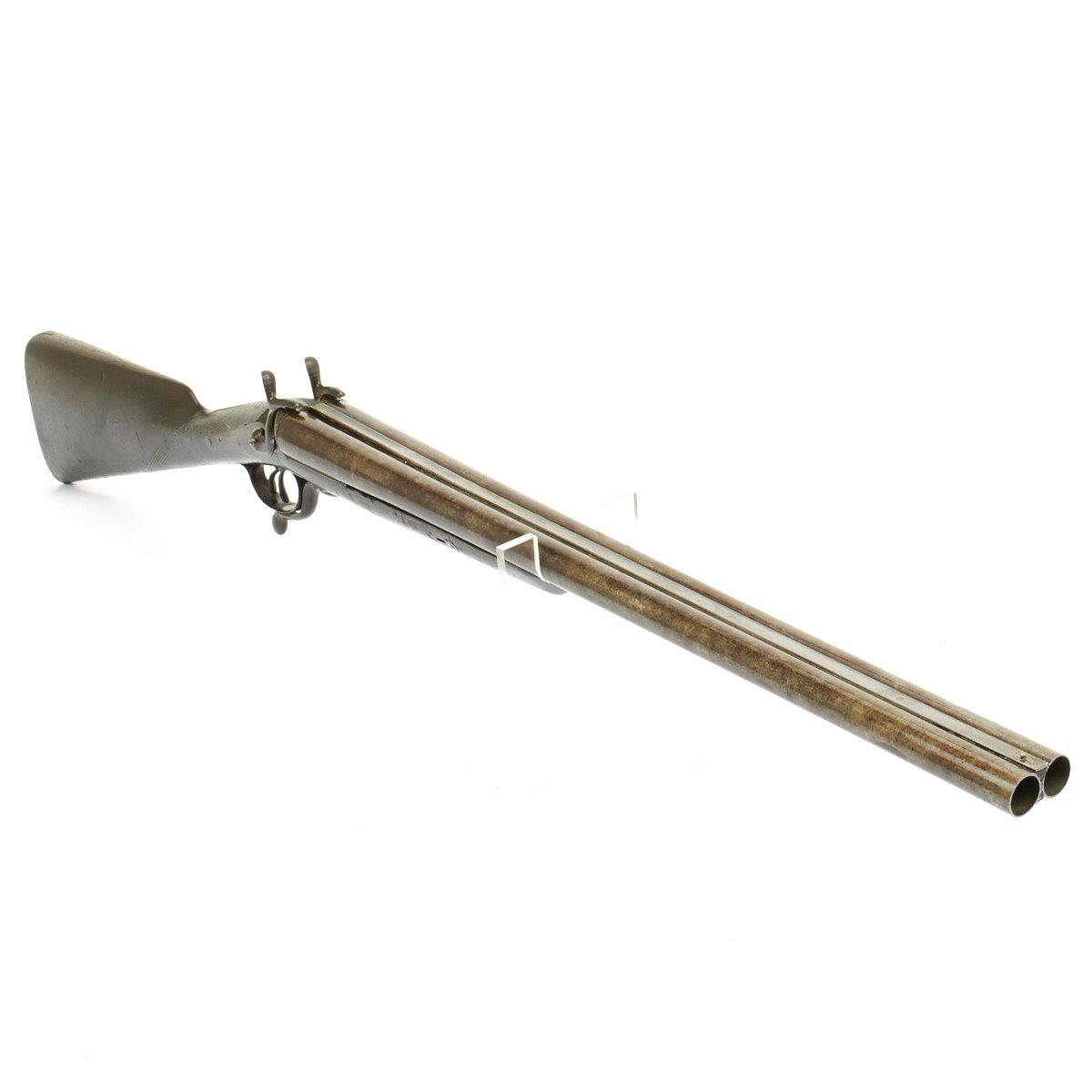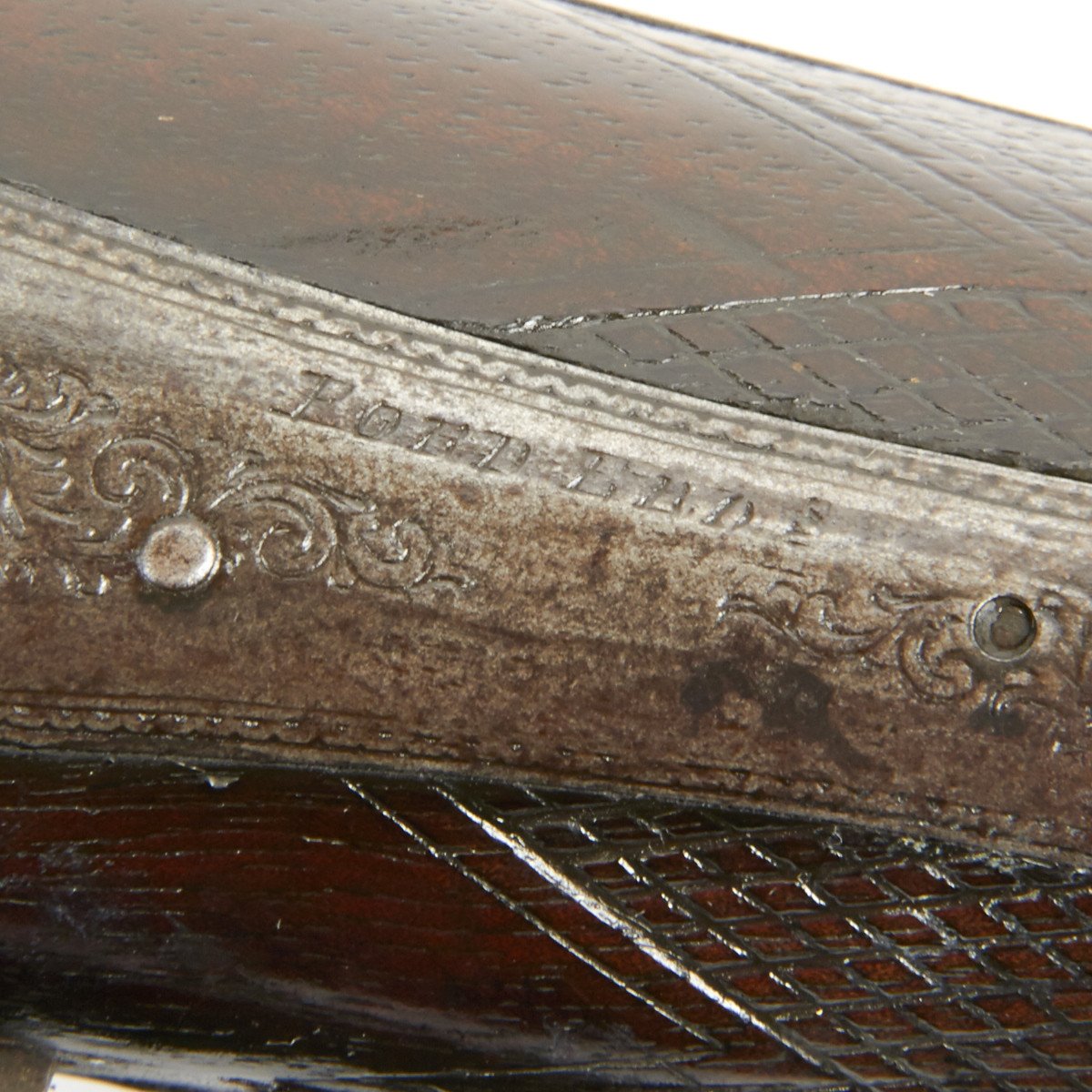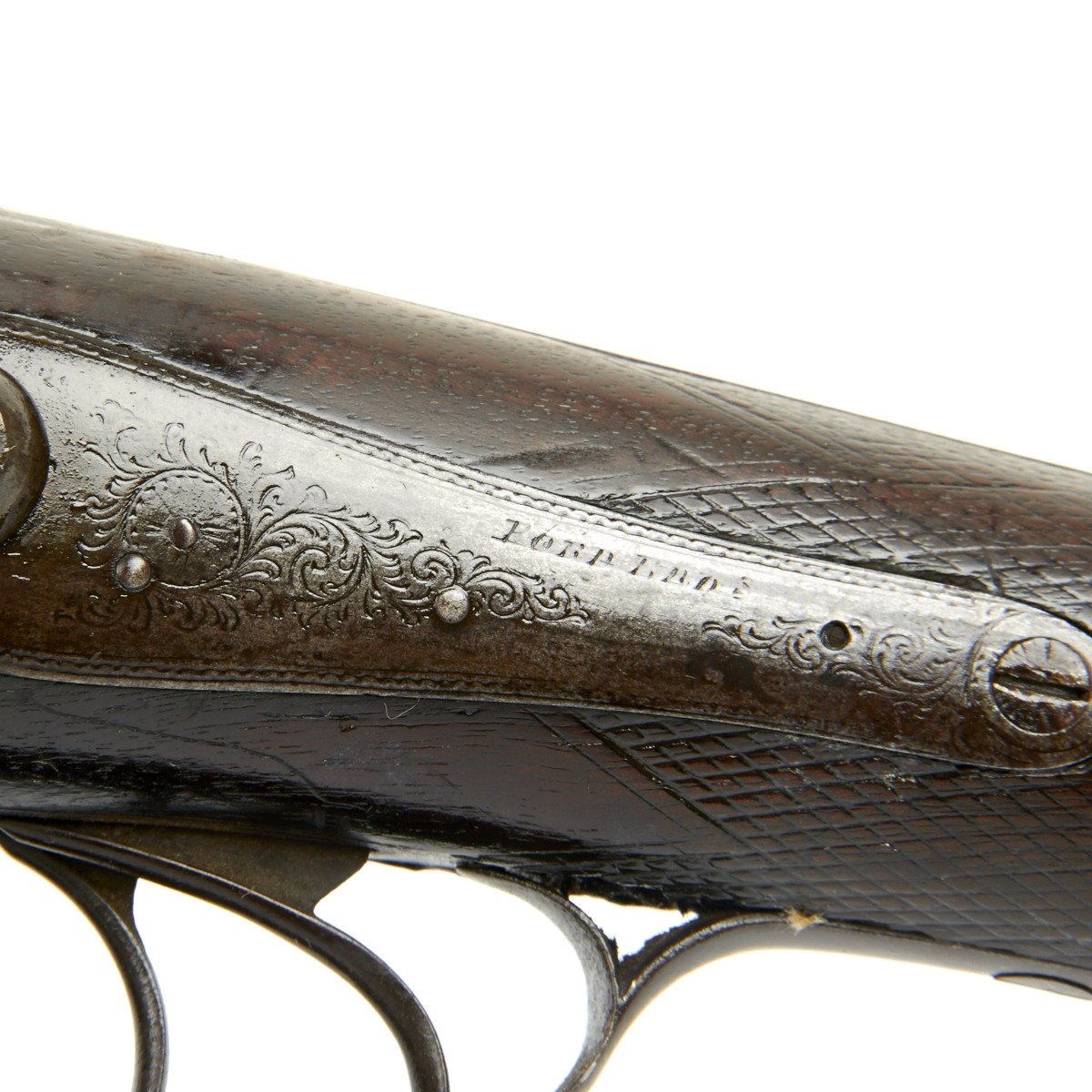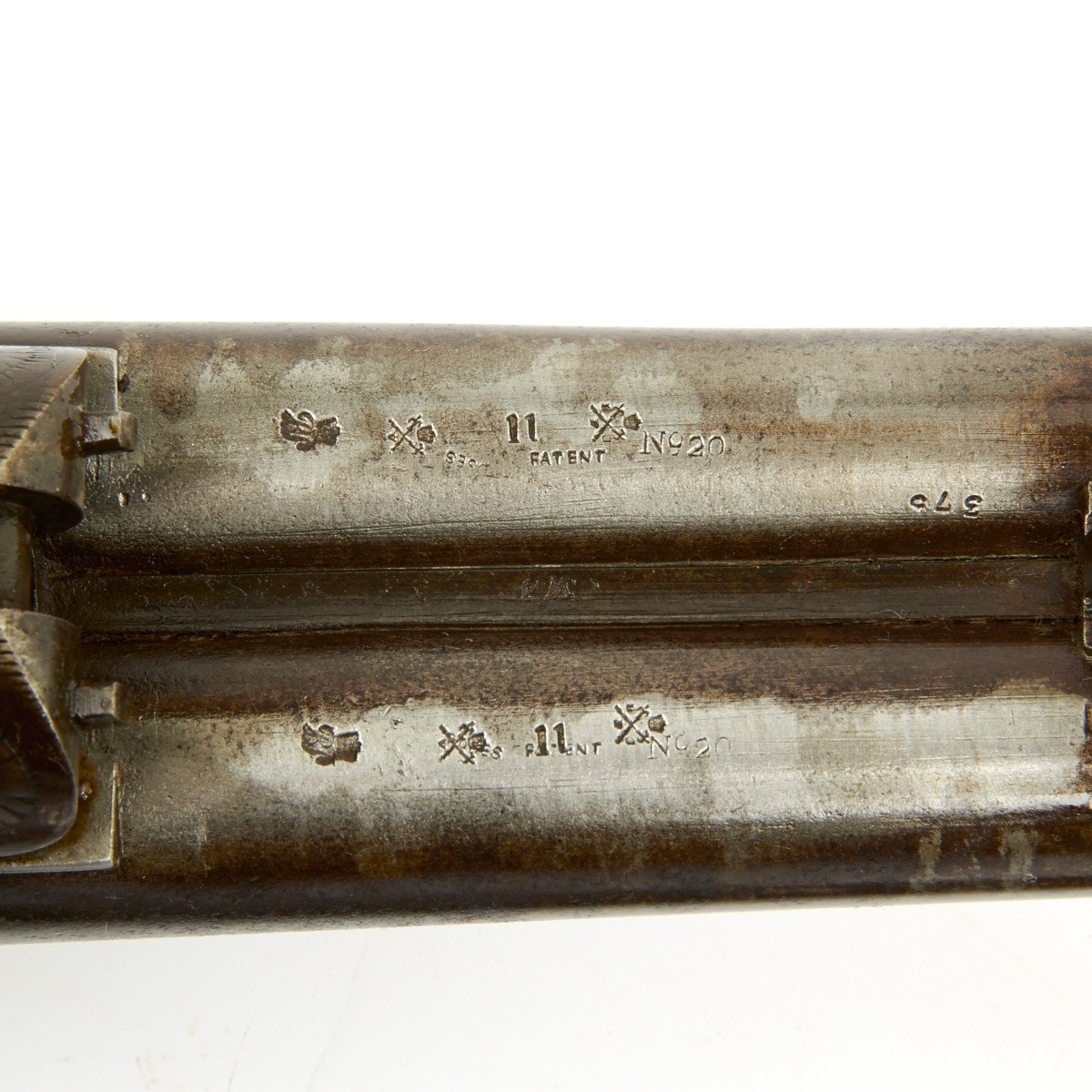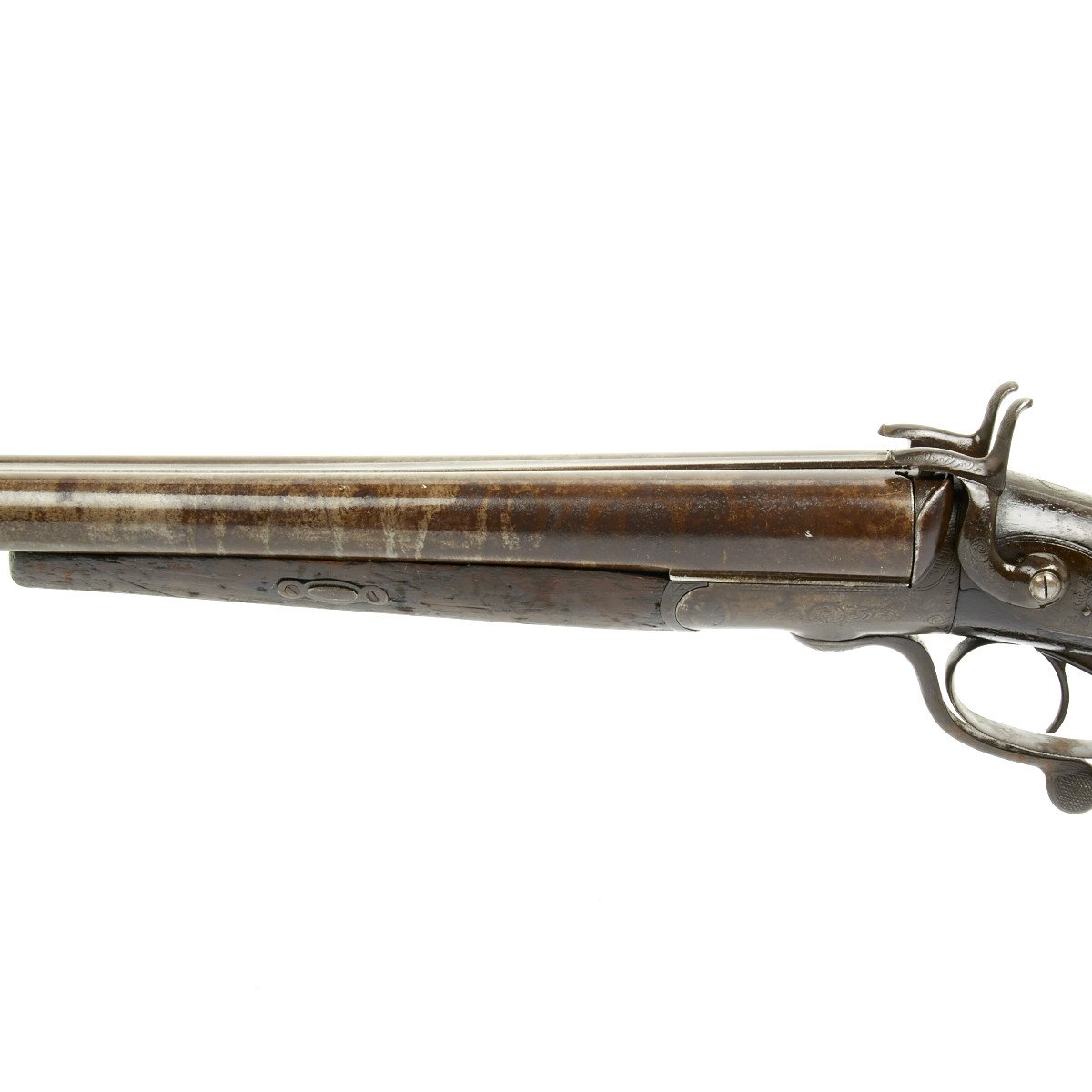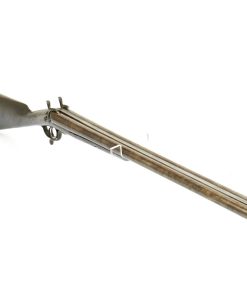Original British 1860 Pin Fire Double Barrel Shot Gun by Ford Brothers – 11 Bore Original Items
$ 595,00 $ 178,50
Original Item: Only One Available. London gun maker Richard Ford worked with his brother and they were collectively known as “FORD BROS” from 1860 to 1868. A pinfire cartridge is an obsolete type of metallic firearm cartridge in which the priming compound is ignited by striking a small pin which protrudes radially from just above the base of the cartridge.
Invented by Frenchman Casimir Lefaucheux in the 1830s but not patented until 1835, it was one of the earliest practical designs of a metallic cartridge. Its history is closely associated with the development of the breechloader which replaced muzzle-loading weapons. The latter required a percussion cap, gunpowder and a projectile or charge be loaded sequentially and packed using wadding and a ramrod. By contrast pinfire cartridges were supremely convenient in that they could contain percussion cap, powder and shot in a neat pre-loaded package which was several times faster to fire and reload and was inherently safer.
This nice example is fitted with short 24″ barrels for easy maneuverability clearly intended for close quarters, such as tavern or stage coach applications.
The pin fire cartridge was ignited by the compression of a “pin” sticking out from one side which struck and internal primer to ignite the charge. The system lasted until the late 1860s being obsoleted by the center fire system which was far safer and more reliable.
History of pin fire:
The Swiss gun maker Samuel Joannes Pauly patented the first breech-loading cartridge in 1812. This was for use in a shotgun with fixed barrels which was loaded by lifting a breech block on the top. French gun maker Henri Roux attempted to improve this cartridge in the 1820s but a constantly primed cartridge was felt by many to be too dangerous and many breech-loading guns reverted to using an unprimed cartridge. This was fired by a separate percussion cap which was used on the still dominant muzzle-loading guns.
Casimir Lefaucheux of Paris decided in 1832 to patent a breechloader where the barrel hinged downwards to reveal the breech ends. These still used a separate percussion cap. Though used before this, (as seen in surviving pinfire shotshells that lists the names of early gun makers he signed contracts with in 1833 and 1834,) in 1835 he was granted an addition to the 1832 patent for a new type of cartridge in which the cartridge’s priming compound is ignited by striking a small pin which protrudes radially from just above the base of the cartridge. These pins fitted into a small groove cut in the top of each barrel-end and made it easy to see if the gun was loaded. The cartridge used metal bases (often brass) with paper tubes which were usually loaded by the shooter or his staff but were not entirely gas-tight. This reduced the force of the charge and allowed powder residue and gas to escape.
The pinfire cartridge was greatly improved by the 1846 patent (number 1963) by Benjamin Houllier of Paris which introduced a base wad and effectively made the cartridge gas-tight which greatly improved the performance, and were cheap and clean shooting. These improved pinfire guns grew in popularity in France and some were imported by British gun makers to overwhelming indifference on the part of the gun users there. They were prejudiced technically against a gun that ‘broke’ in the middle, despite the much vaunted benefits of breechloading.[citation needed] They owned muzzle-loaders of exquisite perfection, considered themselves the best engineers in the world (inventing the Industrial Revolution), and had a poor view of the French – the old enemy and an unreliable ally.
It wasn’t until the Great Exhibition of 1851 was held in London that breech-loading guns were taken more seriously by British and American gun makers in particular. The display of a Lefaucheux breech-loading gun inspired English apprentice gunmaker Edwin Charles Hodges (1831-1925) to make an improved copy and persuade leading London gun maker Joseph Lang that this was the gun of the future. Lang was universally credited to be the first established British gunmaker to produce pinfires in any numbers. His first weapon of this new type was produced in 1853. Other British gun makers including Lancaster, Blanch and Reilly were similarly inspired by French originals and improved pinfire breechloaders became the new type of gun which by 1857/8 every fashionable British prince and titled gentleman wanted to have. EC Hodges continued to make a good living as a specialist independent maker of breech-loading actions commissioned by leading gunmakers such as Boss, Lancaster, Egg, Grant, Atkin, Rigby, Dickson, Purdey, Woodward, Army and Navy, and many others.
After Casimir’s death in 1852, his son Eugene continued to market the pinfire design with great success. It became increasingly popular in Europe and large numbers of shotguns and revolvers (often called Lefaucheux guns after their inventor whoever the maker was), were manufactured from the mid-1850s until the 1890s. They were quicker and easier to load than percussion weapons with loose black powder, percussion caps and bullet; and they were also much more likely to fire reliably when wet. Pinfire cartridges were available in a large number of sizes for various types of weapon.
While pinfire shotguns declined from the early 1860s after the introduction of mass-produced centerfire shotgun cartridges, pinfire revolvers in particular became very successful and widespread, being adopted by the armies of France, Italy, Spain, Switzerland, Sweden and others.[citation needed] They were also used during the American Civil War, although sometimes despised because of their low power compared to Colt and other percussion revolvers. Some navies also adopted them, “sea service” examples often being made out of brass which is largely unaffected by the corrosion caused by salt.
Pinfire became obsolete once reliable rimfire and centerfire cartridges became available because without a pin which needed aligning in the slot in the chamber wall they were quicker to load. They were also safer because they had no protruding pin which could cause the ammunition to accidentally detonate during rough handling, particularly of loose ammunition.
Fast Shipping with Professional Packaging
Thanks to our longstanding association with UPS FedEx DHL, and other major international carriers, we are able to provide a range of shipping options. Our warehouse staff is expertly trained and will wrap your products according to our exact and precise specifications. Prior to shipping, your goods will be thoroughly examined and securely secured. We ship to thousands clients each day across multiple countries. This shows how we're dedicated to be the largest retailer on the internet. Warehouses and distribution centres can be located throughout Europe as well as the USA.
Note: Orders with more than one item will be assigned a processing date depending on the item.
Before shipping before shipping, we'll conduct a thorough inspection of the items you have ordered. Today, the majority of orders will be delivered within 48 hours. The delivery time will be between 3-7 days.
Returns
The stock is dynamic and we cannot completely manage it because multiple stakeholders are involved, including our factory and warehouse. So the actual stock may alter at any time. It's possible that you may not receive your order once the order has been made.
Our policy is valid for a period of 30 days. If you don't receive the product within 30 days, we are not able to issue a refund or an exchange.
You can only return an item if it is unused and in the same state as the day you received it. You must have the item in its original packaging.
Related products
Uncategorized
Uncategorized
Uncategorized
Uncategorized
Uncategorized
Uncategorized
Uncategorized
Uncategorized
Uncategorized
Uncategorized
Australian WWII Owen MK1 Machine Carbine SMG Custom Fabricated Replica with Sling Original Items
Uncategorized
Uncategorized
Uncategorized
Uncategorized
Uncategorized
Uncategorized
Uncategorized
Uncategorized
Uncategorized
